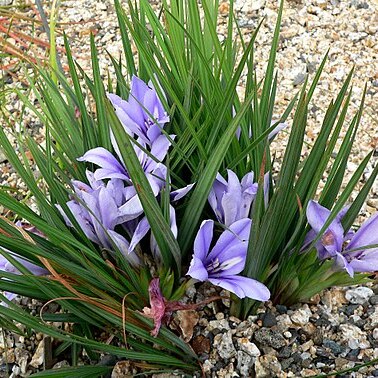Herbs, perennial, rarely annual [or shrubs with woody caudex], evergreen or seasonal, sometimes cespitose; rootstock a rhizome, bulb, or corm. Flowering stems aerial (or subterranean in Romulea), simple or branched, terete or variously compressed, angled or winged. Leaves basal and cauline, distichous; proximal 2–3 sometimes membranous, not reaching much above ground; others with open or closed sheaths, usually unifacial [bifacial or terete], oriented edgewise to the stem; blade parallel-veined, plane or pleated, channeled. Inflorescences umbellate, monochasial cymes (rhipidia), spikes, or solitary flowers; rhipidia enclosed in 2, opposed, usually large, leafy to dry bracts (spathes); flowers except for the first subtended by 1 floral bract; spike flowers each subtended by 2, opposed bracts. Flowers usually pedicellate [± sessile]; per-ianth actinomorphic or zygomorphic, petaloid, with 2 equal or unequal whorls of 3 tepals each [1 whorl of 6]; tepals usually large, showy, distinct or connate in tube; stamens 3 [2], inserted at base of outer tepals or in tube, symmetrically arranged or unilateral, arcuate [declinate]; filaments distinct or partly to completely connate, sometimes weak, unable to support anthers; anthers with 2 pollen sacs, extrorse, occasionally latrorse, usually dehiscing longitudinally [rarely apically]; ovary inferior [superior in Tasmanian Isophysis], 3-locular [1-locular]; placentation axile [parietal]; ovules 2–few, anatropous; style single, filiform at least proximally, usually 3-branched or 3-lobed, branches either filiform, distally expanded, sometimes each divided in distal 1/2, stigmatic toward apices, or branches thickened, or flattened, petaloid, stigmas then abaxial below apices. Fruits capsular, loculicidal, rarely indehiscent, firm to cartilaginous, occasionally woody. Seeds globose to angular (prismatic) or discoid, sometimes broadly winged; seed coat usually dry (rarely fleshy); endosperm hard, with reserves of hemicellulose, oil, and protein; embryo small.
Perennial herbs, rarely annuals or small shrubs, evergreen, or leaves and flowers annual. Rootstock a corm, bulb or sympodial rhizome. Leaves usually distichous, parallel-veined with closed basal sheaths, unifacial and equitant, flat, variously winged or terete, sometimes bifacial and channelled. Inflorescence terminal, cymose, often comprising units (rhipidia) each within often opposed bracts (spathes), the rhipidia variously arranged, or sometimes a spike or reduced to 1 flower; flowers pedicellate or sessile. Flowers bisexual, actinomorphic to zygomorphic. Perianth of 3 sepals and 3 petals in 2 similar or differentiated whorls (sometimes the petals vestigial), free, or connate below in a tube. Stamens 3 (2 in Diplarrena), inserted on perianth tube opposite sepals; anthers bilocular, basifixed to ± versatile; dehiscence usually extrorse by slits. Gynoecium of 3 fused carpels; ovary inferior (superior in Isophysis), trilocular with axile placentation, rarely (not in Australia) unilocular with parietal placentation; style terminal with 3 branches or lobes, sometimes further divided or petaloid; stigmas papillose. Ovules anatropous, usually numerous in each locule. Fruit a capsule; dehiscence loculicidal from apex. Seeds endospermic, sometimes arillate.
Herbs perennial (or shrubs or annuals), with rhizomes, bulbs, or corms. Leaves alternate, often 2-ranked, often oriented edgewise to aerial stem, usually sword-shaped to linear, parallel veined, base sheathing. Inflorescence sometimes a spike or reduced to a solitary flower, more often of monochasial, umbellate cymes, each enclosed in 2 opposed bracts (spathes) and termed a rhipidium, which may be solitary and terminal or numerous and variously arranged in racemes or panicles; bracts 1 to several. Flowers bisexual, showy, usually actinomorphic (often zygomorphic elsewhere). Perianth segments 6, in 2 whorls, inner and outer ones equal or differing in size and/or color; tube filiform or trumpet-shaped. Stamens (2 or)3; anthers extrorse. Ovary inferior (or superior), 3-loculed; ovules few to many; placentation axile. Style with filiform, slender, or petaloid branches. Fruit a loculicidal capsule. Seeds with or without aril and wings.
Ovary inferior (but superior in the Tasmanian Isophysis), trilocular with axile placentation (rarely unilocular with parietal placentation), ovules usually anatropous, many to few; style filiform, usually 3-branched, sometimes simple or 3-lobed, style branches either filiform or distally expanded, sometimes each divided in the upper half, stigmatic towards the apices, or the branches thickened or flattened and petaloid, the stigmas then abaxial below the apices
Leaves basal and cauline; sometimes the lower 2–3 membranous below, entirely sheathing, not reaching much above the ground (thus cataphylls); foliage leaves with open or closed sheaths, the blades mostly distichous, usually equitant and ensiform, parallel-veined, plane, plicate or rarely terete; or leaves bifacial and channelled to flat in a few genera
Inflorescence either composed of umbellate clusters (rhipidia) enclosed in opposed leafy to dry bracts (spathes) with flowers usually pedicellate (to more or less sessile) and each subtended by one bract; or inflorescence spicate with flowers sessile, each subtended by two opposed bracts; or occasionally flowers solitary
Stamens 3, inserted at the base of the outer tepals, or in the perianth tube, symmetrically disposed or unilateral and arcuate (or declinate); filaments filiform, free or partly to completely united; anthers 2-thecous, extrorse, usually dehiscing longitudinally
Fruit a loculicidal capsule, rarely indehiscent; seeds globose to angular or discoid, sometimes broadly winged, usually dry (rarely fleshy), endosperm hard, with reserves of hemicellulose, oil and protein, embryo small
Flowers hermaphrodite, actinomorphic, with a straight perianth-tube or the tube curved, or completely zygomorphic, usually ornamental and often mottled or spotted
Perennial herbs, evergreen or dying back each year to a persistent stock, with rhizomes bulbs or corms, rarely annual herbs, or shrubs with a woody caudex
Flowers hermaphrodite, with a petaloid perianth of two equal or unequal whorls of tepals (rarely one whorl absent), actinomorphic or zygomorphic
Perianth petaloid, withering and persisting for some time; segments or lobes 6, 2-seriate, subequal and similar or different
Leaves often crowded at the base of the stem, mostly linear, flattened at the sides, sheathing at the base and equitant
Ovary inferior, 3-locular with axile, or 1-locular with parietal placentas; style 3-lobed, lobes sometimes petaloid
Tepals usually large and showy, free virtually to the base, or united in a perianth tube
Flowering stems aerial or subterranean, simple or branched, terete, angled or winged
Stamens 3, opposite the outer perianth-lobes; anthers 2-locular, opening by slits
Perennial herbs with underground rhizomes, corms or bulbs
Capsule loculicidally dehiscent by valves
Seeds with copious endosperm
Ovules numerous

